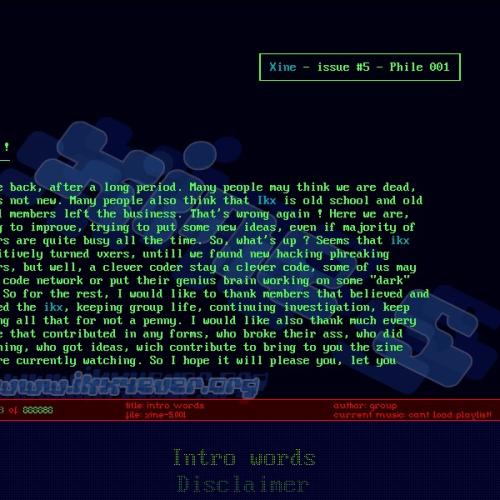Copy Link
Add to Bookmark
Report
xine-2.007

/-----------------------------\
| Xine - issue #2 - Phile 007 |
\-----------------------------/
Userlevel TSR under Win (3.x and 95)
--------------------------------------> by Kernel Panik
Hello All,
in this article I will present some residency, interrupt hooking and
infection techinques suitable for writing viruses under Windows. I
currently tried Win 3.x and 95. They are useful for 16 bit programs
but I am already looking about how to implement them in a Win32 clean
fashion. All this tricks are used in the Homer virus, so please refer to
its source to better understand them.
First of all let me speak about a really easy way to go
resident. It enough to make a normal Windowz program that doesn't
display a window! To say the true it wouldn't be necessary even to
register a window class, but then you need to manually allocate
a callback procedure if you want to get windows messages (for example
you need them in network programming). Homer isn't a very intelligent
virus actually (why do you think I called it so? :-). You can see it
with tools like WinSpy or SoftIce because it registers its class,
but THIS ISN'T NEEDED ACTUALLY. Because windows in 386 mode doesn't
mess with physical address but correctly uses selector you can do
whatever kind of software interrupt hooking without getting in troubles.
So we come to the next interesting point: hooking interrupts and APIs.
Homer implements 4 ways of doing it. Of course they ovelap, but keep
in mind that Homer is an educational virus and is absolutely not
tuned for efficency. Now is time to see this 4 methods:
1) hooking int 21 in PM using DPMI services.
Here your program uses dpmi api (int 31) service ax=0205h to hook
the int 21 in protected mode. This mean that what you get in segment
register are selectors and so you must be careful with this like
RPLs and segment type. If this sounds you strange you better to have
a look at:
a) a 386 programming manual,
b) the Ralf Brown guide to interrupts where is described int 31,
c) some tutorial infomration about PM (for example Andrew Schulman
& Co, books such Windows 95 Unleashed, Dos Programming under
DPMI or similar tutorial floating around on the net).
At the end of your ISR you have to chain the old interrupt handler.
Refer to the source code for more information.
2) hooking int 21 in PM using windows API function GetSetKernelDosProc
This is similar to the previous method as far as the structure of the
handler is concerned. The point is that in this way you see MORE windows
calls because your hooker is called also from windows api functions like
Dos3Call and NoHookDosCall that usually don't generate int 21. A good
discussion of GetSetKernelDosProc can be found, among others, in the
book Undocumented Windows.
3) hooking int 21 in RM using DPMI services.
This is especially useful in the case 32bfa and such are disabled,
because all the int calls are routed to the RM dos. On the other
hand the working of this method is rather complicated. You can
hook the real mode int vector via DPMI but well, Homer is a Windows
(i.e. a protected mode, altought 16 bit) application. You must use a
callback to switch from rm to pm. It's not trivial to understand how
callback (AKA thunking in Win95) works. Basically the Dos Extender
(which BTW provides the DPMI api) installs an exception handler that
gets called when an invalid or illegal opcode is going to be
executed. When you ask DPMI for a callback it gives you an address
(usually in ROM BIOS) of such opcode (usually an ARPL which get
trapped because is allowed only for supervisor program). From
RM you far jump to this address, Dos Extender (i.e. a part of
Windows) get called and from the address that generated error it
knows what pm routine to call (you told him this when you requested
the callback). Now your ISR handler has to convert segment addresses
in selectors, do whatever has to do, adjust the CS:IP address in the
apropiate DPMI structure to the next rm instruction to be executed
and finally return to the do extenders which switch back to rm at
the address you choose. This may seem complicated but works. Please
refer to Homer source for more info.
4) hooking API calls via debugger-like techniques.
This works like the int 3 trick of many debugger (note that it should
be possible to use 386 hardware debugging capabilites) except we use
other ints to avoid incompatibilites. Please note the following
points:
a) we are in protected mode, so we need to make an alias descriptor for
every code selector pointing to a segment we want to change.
b) The trick works cause all windows dll (kernel,user and gdi included)
run in ring 3 protection, so in windows there isn't any protection
scheme between application (apart VMs and VXDs which run at ring 0).
To say the true implementing memory protection on 386+ using segmentation
is very difficult and inefficent (you must have all the GDT's descriptors
at ring 0 and provide every application with an own LDT; but then you must
use slow call or trap or process gates. As a pointless digression let me
say that, for example, Linux which IS A SMART OS uses the memory
protection provided by the paging mechanism which distinguish only
between user/supervisor mode in 4GB flat address spaces like other processors
(Motorola 680xx family does, for example) does. I think this Intel madness comes
from the need for compatibility with 286 and 8086 and, on the long run,
will represent an advantage for other architectures like Alpha or PPC).
c) there is a rather wired procedure of getting from the stack the
parameters needed for the api to work. Here a debugger like SoftIce and
an API reference are your only friends. Please note also the difficulty
of adjusting CS:IP pushed on the stack by the INT instruction.
d) for simplicity Homer reactivates API hooks only once a second, because
this was the first simply way to do it that I tought. Quite sure there
are better way to do it, but i didn't want to go to deep in using the
trace flag or emulating opcodes.
e) this works flawlessy cause windows 16 is NOT preempive and win 16
apis are NOT, by their very own nature, reentrant. You just need
to keep a reference to the DLL you use to prevent Windows to discard it.
This isn't a problem for kernel, user and gdi.
f) see also the hooking of the winsock.dll library for an example of this
techique.
Last but not least some word about NE infection. The routine that does it
is a translation in C of b0z0 assembler code. It is an ugly translation,
cause I am too lazy and busy for a good reengineering using high level
language constructs. The innovative part is the strategy of piggybacking
of the viral code. The victim gets appended a small runcode chunk and the
.exe image of Homer. The runcode just dumps Homer image to a file and
executes it via an int 21 exec and after that chains the victim. This could
be somehow called an "inverse companion". You can clearly see the KISS
philosophy: keep it simple stupid. BTW when the virus stars at first it
copies his .exe image to memory for infection.
This works well, altough Homer is rather silly and doesn't implement none
but the more trivial stealth techiques. Remember ... Homer is a tutorial
virus you can enhanche by using your creativity and your skills! But
remember: be creative and NOT destructive agains innocent's machines ...
this would be only a sign of lamerness.




















